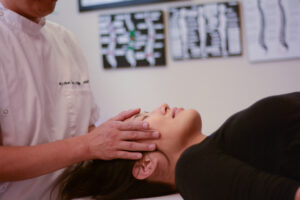If you are one of the millions of Canadians who have arthritis, I would like to let you know that Osteopathy can be a gentle and effective way to reduce arthritis symptoms.
A common form of arthritis is called osteoarthritis. This is a degenerative joint condition that primarily affects the hands, feet, hips, knees and spine. Many people think of osteoarthritis as being caused by the natural “wear and tear” on the body over time. There are many possible factors involved in the development of osteoarthritis including genes, weight, posture, heavy manual work, previous joint injuries, and lack of exercise. New research also indicates osteoarthritis can also be viewed as a malfunction of bone and cartilage metabolism.
Rheumatoid arthritis is an auto-immune disease that can affect all the joints in the body with chronic inflammation. This is different from simple wear and tear. The symptoms of rheumatoid arthritis tend to be more severe.
In some cases, x-ray examinations or MRI scans may be necessary to confirm a diagnosis. As an osteopathic manual practitioner, there are many methods available that I can use to help you reduce and possibly eliminate pain, stiffness, and other arthritis symptoms.
In osteoarthritis, pain and inflammation can result from the thinning of discs or cartilage between the bony surfaces of joints. When this occurs, the soft tissues surrounding the joint shorten, making the joint stiffer and less likely to be used. While this is a protective mechanism the body has devised to protect the joint, using the joint less results in less joint lubrication, drainage and delivery of nutrients to the joint. Additionally, muscles in the affected area can become weaker due to the reduced use.
How can Osteopathy Help Arthritis Sufferers?
The goal of osteopathic treatment of arthritis is to reduce the imbalances in the body that are contributing to the symptoms. I use a hands-on technique called osteopathic palpation to identify and assess areas of weakness or excessive tension in the body. Once these imbalances are identified, I will use gentle manual techniques on the joints and the soft tissues of the body to help the body regain its structural balance.
Often, these manual treatments will involve gently encouraging the affected joint(s) to move. There is a fine balance between using and aggravating an arthritic joint, which is why the manual treatments are always gentle in nature. Osteopathic treatment of arthritis has been shown to help to reduce pain and inflammation.
In addition to these manual treatments, I will also make other suggestions on how to reduce your arthritis symptoms. I will teach you various stretches as appropriate, and provide advice on you can help yourself through home exercises, posture improvements, and other lifestyle changes that can help ease your symptoms.
Frequently Asked Questions about Osteoarthritis
No. A characteristic of osteoarthritis is increased bone density. You may be thinking of the medical condition “osteoporosis”, which is a bone disorder in which the bones become weak due loss of bone mass.
There is no direct relationship between calcium intake and osteoarthritis. In osteoarthritis, there is a breakdown of the cartilage between the joints. Vitamins A, C and E have been identified as potentially protecting cartilage due to their antioxidant effects in the body.
Yes. You will often see Osteoarthritis referred to as Degenerative Joint Disease.
If you’re a very active person who sustains joint injuries, you may have an increased chance of developing arthritis as you age. Smoking and obesity can also contribute to a higher risk of developing arthritis.
X-rays can be helpful, but one who has arthritis symptoms may not see any joint abnormalities on an x-ray. There are also people who have visible joint changes on their x-rays but who don’t have symptoms of osteoarthritis. Pain is a complicated process and it’s different for everyone.









